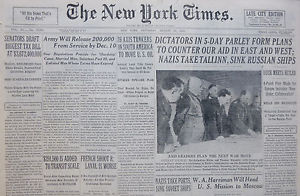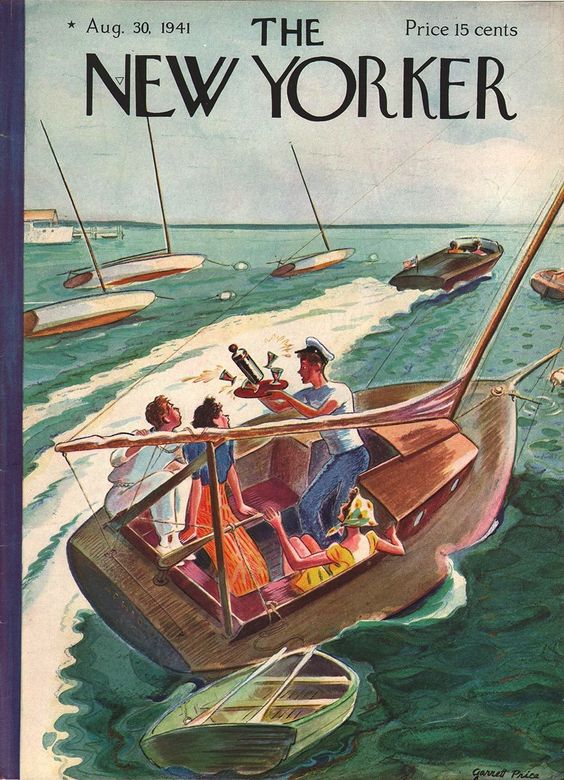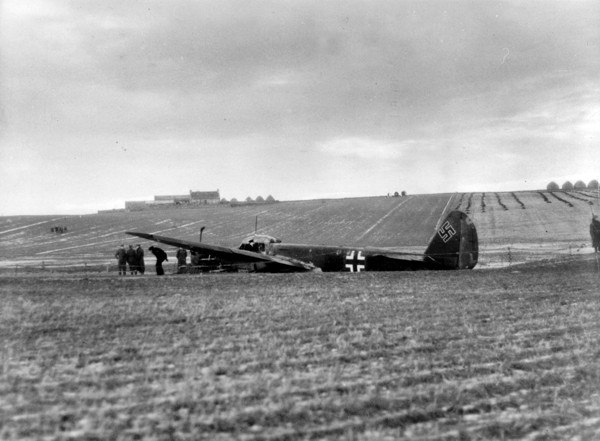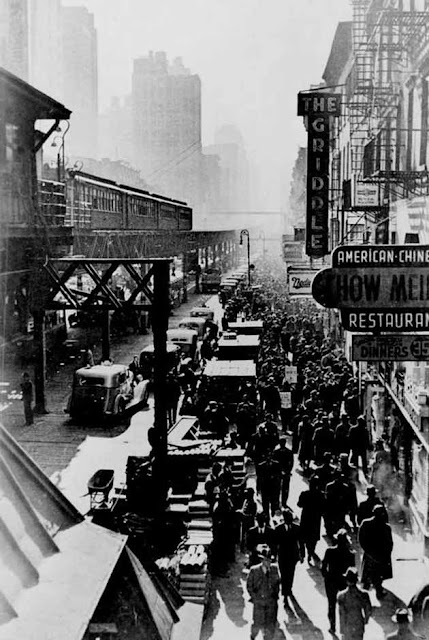Saturday 30 August 1941
 |
| Adolf Hitler with Benito Mussolini (left), Hermann Goering, and Field Marshall Keitel during a visit to the headquarters of Field Marshal Walther von Brauchitsch, 30 August 1941. |
Eastern Front: In the Far North sector on 30 August 1941, Finnish troops on the Karelian Isthmus are approaching the old border and capture Raivola. Finnish IV Corps is in the west, II Corps in the center, and I Corps on the eastern side. Marshal Mannerheim issues an order to the three Corps to stop short of the old Soviet fortifications on the other side of the border. The Germans have no say in this and apparently are not even informed. In fact, the Germans still think that the Finns will mount a major assault on Leningrad from the north - which Mannerheim already has decided against.
In the Army Group North sector, the Germans take Mga, about 20 miles southeast of Leningrad. This cuts the last rail link to Leningrad and puts the Wehrmacht in a good position to take Schlusselburg and cut the last road into the city as well.
In the Army Group Center sector, the Soviets resume their counteroffensive against the Wehrmacht's "lightning rod" position at Yelnya. This is resumed in conjunction with other attacks by Western Front and Bryansk Front (General Andrey Eremenko) and thus constitutes the first coordinated Soviet offensive. The German German front holds, but the Soviet troops make an advance of about 10 km on the south flank that threatens encirclement. Field Marshal von Bock has to send the 10th Panzer Division (Lt Gen F. Schaal) and an infantry division to prevent a breakthrough.
In the Army Group South sector, the Romanian 4th Army resumes its attack on Odesa after blunting a Soviet counterattack on the 29th. However, the Soviet defenders are fighting with desperation, and even retake Kubanka (site of the Romanian artillery) before being driven back before dark. The Germans are displeased with the Romanian tactics, which have no subtlety and resemble the trench warfare of World War I and massive casualties resulting from frontal attacks - but that is exactly the kind of battle the Soviets want.
General Guderian continues trying to break through the Soviet line north of Kyiv but faces fierce resistance. The German plan is for Guderian to form an encirclement with Panzer Group 2 (Gen von Kleist) to trap the 850,000 Soviet troops defending Kyiv under General Kirponos and Marshal Budenny. German 2nd Army, pushing south to the west of Guderian's troops, approaches Chernihiv.
European Air Operations: The RAF sends six Blenheim bombers on a Channel sweep during the day, but they are recalled without loss.
After dark, RAF Bomber Command sends 5 Wellingtons and a Stirling to attack Cherbourg docks and two on minelaying off Warnemunde. There are no losses in either mission.
One of the few Luftwaffe lone raiders attacking England hits a balloon cable over the Humber Estuary. The damage causes it to crash into the North Sea. The crew is rescued by a German ship on 4 September.
Battle of the Baltic: Now that the convoys from Tallinn are safely at Kronstadt (more or less), the Soviet Baltic Fleet provides gunfire support to the Leningrad Front. The force is organized into three groups:
German shore artillery shells and sinks Soviet MO-4-class patrol boat MO-202.
Soviet MO-2-class patrol boats No. 173 and 174 are lost today, perhaps due to German shore-based artillery as well.
After dark, the German 5th R-Boat Flotilla lays 32 mines between minefield Juminda and Finnish minefield Valkjarvi.
Battle of the Atlantic: Off of the Lofoten Islands in northern Norway, Royal Navy submarine HMS Trident (Cdr Sladen) comes upon a convoy of German freighters and goes to work. He torpedoes and sinks:
Operation Strength, a Royal Navy delivery of 24 Hurricanes to the Soviet Air Force at Vaenga by HMS Argus, begins. Argus, escorted by heavy cruiser Shropshire and destroyers, departs from Scapa Flow bound for Seidisfjord.
Convoy Dervish, the first supply convoy to the Soviet Union, arrives at Spitsbergen. There it refuels before proceeding on to Archangel.
Convoy WS-11 (Winston Special) departs from Liverpool bound (eventually) for Colombo and Singapore, where it arrives on 6 November. Convoy ON-11 departs from Liverpool, Convoy SC-42 (65 ships) departs from Sydney, Cape Breton, Nova Scotia bound for Liverpool.
US Navy battleship USS New Mexico leads Task Group TG1.1.2 out of Hvalfjord, Iceland to patrol the Denmark Strait. This is due to a report of a suspicious vessel (presumed to be a German Hipper-class cruiser) between there and Bermuda by US Coast Guard cutter Alexander Hamilton. The thinking is that it is a German ship returning from a raiding expedition that will seek to use the Denmark Strait to return to Norway. What exactly the Task Group would do if it spotted such a ship is a bit unclear - typically, they are just supposed to notify the Royal Navy to take action. However, an awful lot of US firepowers is present just to use the radio.
A German blockade runner, 8306-ton tanker Benno (formerly Norwegian Ole Jacob), departs from Bordeaux, France bound for Kobe, Japan.
Royal Navy sloop HMS Ibis (Lt. Commander Henry M. Darell-Brown) is commissioned and sloop Cygnet is laid down.
Canadian minesweeper HMCS Quinte is commissioned.
U-136 (Kapitänleutnant Heinrich Zimmermann), U-213 (Oberleutnant zur See Amelung von Varendorff), and U-435 (Kapitänleutnant Siegfried Strelow) are commissioned, U-253 is launched, and U-305 is laid down.
Battle of the Mediterranean: Royal Navy submarine HMS Unbeaten (Lt Woodward) uses its deck gun to sink 373-ton Italian auxiliary patrol boat V.51/Alfa off Augusta, Sicily.
RAF Swordfish based on Malta of No. 830 Squadron torpedo and sink 861-ton Italian freighter Egadi about 30 miles northeast of Lampedusa.
The RAF attacks Tripoli with 9 Wellington bombers and they sink:
Australian minesweeper HMAS Ballarat (Lt. Alfred D. Barling) is commissioned.
Special Operations: After dark, Operation Acid, a British Commando raid, begins. No. 5 Commando sends two separate teams, each composed of one officer and 14 soldiers, to separate beaches in the Pas-de-Calais, France (Hardelot and Merlimont). The Commandos perform reconnaissance and try to capture a German sentry. However, the Commandos do not encounter any Germans and leave after 30 minutes.
Operation Gauntlet, the Royal Navy raid on Spitzbergen, continues without any interference from the Germans. The Norwegian operators of the radio station keep the Luftwaffe away by sending false reports of heavy fog to the mainland, and the Canadians quickly capture any ships that appear. Overall, the raid is a resounding success, and the Canadian troops continue destroying mining equipment and rendering the island useless to the Germans.
Iran Invasion: With a ceasefire in effect while the opposing parties dicker over terms of an armistice, the Soviets occupy the "open city" of Qazvin. This is 94 miles (151 km) from Tehran. The Soviets also take the "non-open" city of Hamadan after some light bombing that kills a small child.
The Soviet troops remain on the move throughout the day, while the British are content to stop and allow negotiations to play out. The Soviets and British have agreed beforehand to occupy their respective spheres of influence contained in a 1908 agreement, so there is little point to being aggressive at this point - as long as the British and Soviets trust each other. Elements of the Indian 10th Infantry Division enter Kermanshah.
Soviet and British troops meet at Sinneh.
Italian/Japanese Relations: Italy has learned through press reports of Ambassador Nomura's meeting with President Roosevelt on the 29th, so Italian Ambassador to the US Don Ascanio dei principi Colonna meets with Ambassador Nomura. Nomura tries to fob him off with generalities about the meeting, but Colonna is not satisfied. Nomura then adds that Japan would continue to abide by the Tripartite Pact, but was simply trying to avoid war in the Pacific. Nomura later, however, cables Tokyo and states that he successfully maintained secrecy about the true nature of Prince Konoye's note to President Roosevelt, including the proposed summit meeting.
German/Japanese Relations: Tokyo sends a message to Berlin stating that Ambassador Nomura had simply carried on informal discussions with Secretary Hull and then submitted a note to President Roosevelt whose contents had been revealed to the world press. However, the statements by Japan and the US did not reveal the true contents of Prince Konoye's message to Roosevelt, so this remains a secret from Japan's allies.
German Foreign Minister Ribbentrop asks his Japanese counterpart, Soemu Toyoda, if the Japanese would be willing to attack the Soviet port of Vladivostok. The Japanese already have decided against this, but Toyoda responds that Japan indeed is preparing for such an attack but just needs a little more time.
German/Romanian Relations: The Germans and Romanians reach agreements on Romanian administration of Transnistria - which would include Odessa.
British/Soviet Relations: Joseph Stalin receives a message from Winston Churchill which is very fulsome and promises continued aid. Specifically, Churchill promises that two RAF squadrons of 40 aircraft will arrive at Murmansk by 6 September along with 200 P-40 Tomahawk fighters, and perhaps 200 more Hurricanes later for a total of 440 fighters. Churchill, unaware of the furious US/Japanese negotiations in progress, also notes that President Roosevelt "seems disposed... to take a strong line against further Japanese aggression."
Requisitioned 10,439-ton Hokoku Maru begins its conversion into an armed merchant cruiser with the installation of four 6-inch (152-mm) guns and other equipment.
American Homefront: "Dive Bomber," directed by Michael Curtiz ("Casablanca") and starring Errol Flynn and Fred MacMurray, is released by Warner Bros. It is a technicolor war drama that contains a lot of footage of US aircraft and aircraft carrier USS Enterprise. The US Department of the Navy gives its full cooperation and requests that it be made and released as soon as possible for recruiting purposes. The new SBD Dauntless dive bomber is featured. Filming takes place at Eglin Field, Florida, North Field at NAS San Diego and Naval Station San Diego, California. "Dive Bomber" becomes the sixth most popular film of 1941 and Warner Bros.' top earner for the year.
"Green Eyes" (Aquellos Ojos Verdes) by Jimmy Dorsey and His Orchestra with Bob Eberly and Helen O'Connell hits No. 1 on the Billboard chart. It is Jimmy Dorsey's fourth Number One hit of 1941 - and not his last, either.
August 1941
August 1, 1941: More Executions on Crete
August 2, 1941: Uman Encirclement Closes
August 3, 1941: Bishop von Galen Denounces Euthanasia
August 4, 1941: Hitler at the Front
August 5, 1941: Soviets Surrender at Smolensk
August 6, 1941: U-Boats in the Arctic
August 7, 1941: Soviets Bomb Berlin
August 8, 1941: Uman Pocket Captured
August 9, 1941: Atlantic Conference at Placentia Bay
August 10, 1941: Soviet Bombers Mauled Over Berlin
August 11, 1941: Rita Hayworth in Life
August 12, 1941: Atlantic Charter Announced
August 13, 1941: The Soybean Car
August 14, 1941: The Anders Army Formed
August 15, 1941: Himmler at Minsk
August 16, 1941: Stalin's Order No. 270
August 17, 1941: Germans in Novgorod
August 18, 1941: Lili Marleen
August 19, 1941: Convoy OG-71 Destruction
August 20, 1941: Siege of Leningrad Begins
August 21, 1941: Stalin Enraged
August 22, 1941: Germans Take Cherkassy
August 23, 1941: Go to Kiev
August 24, 1941: Finns Surround Viipuri
August 25, 1941: Iran Invaded
August 26, 1941: The Bridge Over the Desna
August 27, 1941: Soviets Evacuate Tallinn
August 28, 1941: Evacuating Soviets Savaged
August 29, 1941: Finns take Viipuri
August 30, 1941: Operation Acid
August 31, 1941: Mannerheim Says No
2020
In the Army Group North sector, the Germans take Mga, about 20 miles southeast of Leningrad. This cuts the last rail link to Leningrad and puts the Wehrmacht in a good position to take Schlusselburg and cut the last road into the city as well.
In the Army Group Center sector, the Soviets resume their counteroffensive against the Wehrmacht's "lightning rod" position at Yelnya. This is resumed in conjunction with other attacks by Western Front and Bryansk Front (General Andrey Eremenko) and thus constitutes the first coordinated Soviet offensive. The German German front holds, but the Soviet troops make an advance of about 10 km on the south flank that threatens encirclement. Field Marshal von Bock has to send the 10th Panzer Division (Lt Gen F. Schaal) and an infantry division to prevent a breakthrough.
In the Army Group South sector, the Romanian 4th Army resumes its attack on Odesa after blunting a Soviet counterattack on the 29th. However, the Soviet defenders are fighting with desperation, and even retake Kubanka (site of the Romanian artillery) before being driven back before dark. The Germans are displeased with the Romanian tactics, which have no subtlety and resemble the trench warfare of World War I and massive casualties resulting from frontal attacks - but that is exactly the kind of battle the Soviets want.
General Guderian continues trying to break through the Soviet line north of Kyiv but faces fierce resistance. The German plan is for Guderian to form an encirclement with Panzer Group 2 (Gen von Kleist) to trap the 850,000 Soviet troops defending Kyiv under General Kirponos and Marshal Budenny. German 2nd Army, pushing south to the west of Guderian's troops, approaches Chernihiv.
 |
| Adolf Hitler and Benito Mussolini acknowledge the salutes of the troops at Field Marshal von Brauchitsch's headquarters, 30 August 1941. |
After dark, RAF Bomber Command sends 5 Wellingtons and a Stirling to attack Cherbourg docks and two on minelaying off Warnemunde. There are no losses in either mission.
One of the few Luftwaffe lone raiders attacking England hits a balloon cable over the Humber Estuary. The damage causes it to crash into the North Sea. The crew is rescued by a German ship on 4 September.
 |
| Soviet soldiers of the Voroshilov Regiment in training, Moscow, 30 August 1941. |
- Group 1 (three destroyers and three gunboats) operating in the Neva River to support Soviet 42nd and 55th Armies south of Leningrad
- Group 2 (two cruisers, destroyer leader Leningrad, five destroyers, and one minelayer) supporting troops east of Leningrad
- Group 3 (two battleships, cruiser Kirov (recently damaged), a destroyer leader, four destroyers, two additional damaged destroyers, and a gunboat) supporting troops defending the Kronstadt naval base on Kotlin Island.
German shore artillery shells and sinks Soviet MO-4-class patrol boat MO-202.
Soviet MO-2-class patrol boats No. 173 and 174 are lost today, perhaps due to German shore-based artillery as well.
After dark, the German 5th R-Boat Flotilla lays 32 mines between minefield Juminda and Finnish minefield Valkjarvi.
 |
| A Russian woman tries to shelter her baby while Axis forces shell the small village of Krasnaya Sloboda. August 30th, 1941. |
- 2931-ton freighter Donau II
- 8561-ton freighter Bahia Laura
Operation Strength, a Royal Navy delivery of 24 Hurricanes to the Soviet Air Force at Vaenga by HMS Argus, begins. Argus, escorted by heavy cruiser Shropshire and destroyers, departs from Scapa Flow bound for Seidisfjord.
Convoy Dervish, the first supply convoy to the Soviet Union, arrives at Spitsbergen. There it refuels before proceeding on to Archangel.
Convoy WS-11 (Winston Special) departs from Liverpool bound (eventually) for Colombo and Singapore, where it arrives on 6 November. Convoy ON-11 departs from Liverpool, Convoy SC-42 (65 ships) departs from Sydney, Cape Breton, Nova Scotia bound for Liverpool.
US Navy battleship USS New Mexico leads Task Group TG1.1.2 out of Hvalfjord, Iceland to patrol the Denmark Strait. This is due to a report of a suspicious vessel (presumed to be a German Hipper-class cruiser) between there and Bermuda by US Coast Guard cutter Alexander Hamilton. The thinking is that it is a German ship returning from a raiding expedition that will seek to use the Denmark Strait to return to Norway. What exactly the Task Group would do if it spotted such a ship is a bit unclear - typically, they are just supposed to notify the Royal Navy to take action. However, an awful lot of US firepowers is present just to use the radio.
A German blockade runner, 8306-ton tanker Benno (formerly Norwegian Ole Jacob), departs from Bordeaux, France bound for Kobe, Japan.
Royal Navy sloop HMS Ibis (Lt. Commander Henry M. Darell-Brown) is commissioned and sloop Cygnet is laid down.
Canadian minesweeper HMCS Quinte is commissioned.
U-136 (Kapitänleutnant Heinrich Zimmermann), U-213 (Oberleutnant zur See Amelung von Varendorff), and U-435 (Kapitänleutnant Siegfried Strelow) are commissioned, U-253 is launched, and U-305 is laid down.
 |
| Clark Gable, Movie-radio Guide Magazine [United States] (30 August 1941). Gable would be in uniform and flying bomber missions within two years. |
RAF Swordfish based on Malta of No. 830 Squadron torpedo and sink 861-ton Italian freighter Egadi about 30 miles northeast of Lampedusa.
The RAF attacks Tripoli with 9 Wellington bombers and they sink:
- 6630-ton Italian freighter RIV
- 395-ton Italian freighter Neptunus
- 367-ton Italian freighter Giuseppina V
- 393-ton Italian freighter Fiametta
Australian minesweeper HMAS Ballarat (Lt. Alfred D. Barling) is commissioned.
 |
| The Australian Women's Weekly, 30 August 1941. |
Operation Gauntlet, the Royal Navy raid on Spitzbergen, continues without any interference from the Germans. The Norwegian operators of the radio station keep the Luftwaffe away by sending false reports of heavy fog to the mainland, and the Canadians quickly capture any ships that appear. Overall, the raid is a resounding success, and the Canadian troops continue destroying mining equipment and rendering the island useless to the Germans.
Iran Invasion: With a ceasefire in effect while the opposing parties dicker over terms of an armistice, the Soviets occupy the "open city" of Qazvin. This is 94 miles (151 km) from Tehran. The Soviets also take the "non-open" city of Hamadan after some light bombing that kills a small child.
The Soviet troops remain on the move throughout the day, while the British are content to stop and allow negotiations to play out. The Soviets and British have agreed beforehand to occupy their respective spheres of influence contained in a 1908 agreement, so there is little point to being aggressive at this point - as long as the British and Soviets trust each other. Elements of the Indian 10th Infantry Division enter Kermanshah.
Soviet and British troops meet at Sinneh.
 |
| Parade for Queen Wilhelmina's birthday on Aruba by the 4th Cameron Highlanders, 30 August 1941 (Ingleby Jefferson). |
German/Japanese Relations: Tokyo sends a message to Berlin stating that Ambassador Nomura had simply carried on informal discussions with Secretary Hull and then submitted a note to President Roosevelt whose contents had been revealed to the world press. However, the statements by Japan and the US did not reveal the true contents of Prince Konoye's message to Roosevelt, so this remains a secret from Japan's allies.
German Foreign Minister Ribbentrop asks his Japanese counterpart, Soemu Toyoda, if the Japanese would be willing to attack the Soviet port of Vladivostok. The Japanese already have decided against this, but Toyoda responds that Japan indeed is preparing for such an attack but just needs a little more time.
 |
| "Dictators in 5-Day Parley Form Plans to Counter Our Aid in East and West," New York Times, 30 August 1941. |
British/Soviet Relations: Joseph Stalin receives a message from Winston Churchill which is very fulsome and promises continued aid. Specifically, Churchill promises that two RAF squadrons of 40 aircraft will arrive at Murmansk by 6 September along with 200 P-40 Tomahawk fighters, and perhaps 200 more Hurricanes later for a total of 440 fighters. Churchill, unaware of the furious US/Japanese negotiations in progress, also notes that President Roosevelt "seems disposed... to take a strong line against further Japanese aggression."
Requisitioned 10,439-ton Hokoku Maru begins its conversion into an armed merchant cruiser with the installation of four 6-inch (152-mm) guns and other equipment.
American Homefront: "Dive Bomber," directed by Michael Curtiz ("Casablanca") and starring Errol Flynn and Fred MacMurray, is released by Warner Bros. It is a technicolor war drama that contains a lot of footage of US aircraft and aircraft carrier USS Enterprise. The US Department of the Navy gives its full cooperation and requests that it be made and released as soon as possible for recruiting purposes. The new SBD Dauntless dive bomber is featured. Filming takes place at Eglin Field, Florida, North Field at NAS San Diego and Naval Station San Diego, California. "Dive Bomber" becomes the sixth most popular film of 1941 and Warner Bros.' top earner for the year.
"Green Eyes" (Aquellos Ojos Verdes) by Jimmy Dorsey and His Orchestra with Bob Eberly and Helen O'Connell hits No. 1 on the Billboard chart. It is Jimmy Dorsey's fourth Number One hit of 1941 - and not his last, either.
 |
| The New Yorker, 30 August 1941 (cover by Garrett Price). |
August 1941
August 2, 1941: Uman Encirclement Closes
August 3, 1941: Bishop von Galen Denounces Euthanasia
August 4, 1941: Hitler at the Front
August 5, 1941: Soviets Surrender at Smolensk
August 6, 1941: U-Boats in the Arctic
August 7, 1941: Soviets Bomb Berlin
August 8, 1941: Uman Pocket Captured
August 9, 1941: Atlantic Conference at Placentia Bay
August 10, 1941: Soviet Bombers Mauled Over Berlin
August 11, 1941: Rita Hayworth in Life
August 12, 1941: Atlantic Charter Announced
August 13, 1941: The Soybean Car
August 14, 1941: The Anders Army Formed
August 15, 1941: Himmler at Minsk
August 16, 1941: Stalin's Order No. 270
August 17, 1941: Germans in Novgorod
August 18, 1941: Lili Marleen
August 19, 1941: Convoy OG-71 Destruction
August 20, 1941: Siege of Leningrad Begins
August 21, 1941: Stalin Enraged
August 22, 1941: Germans Take Cherkassy
August 23, 1941: Go to Kiev
August 24, 1941: Finns Surround Viipuri
August 25, 1941: Iran Invaded
August 26, 1941: The Bridge Over the Desna
August 27, 1941: Soviets Evacuate Tallinn
August 28, 1941: Evacuating Soviets Savaged
August 29, 1941: Finns take Viipuri
August 30, 1941: Operation Acid
August 31, 1941: Mannerheim Says No
2020







